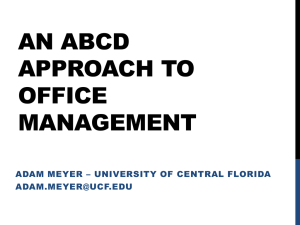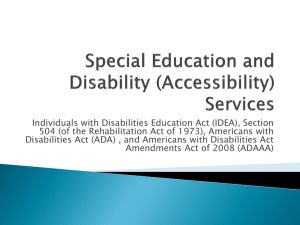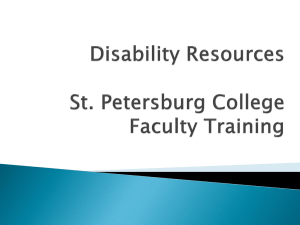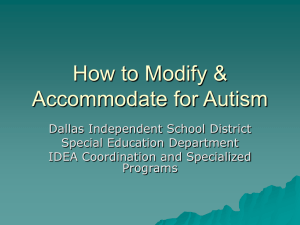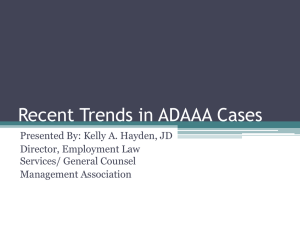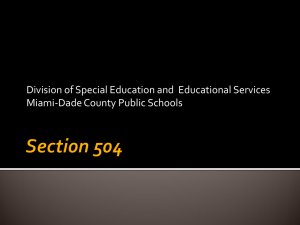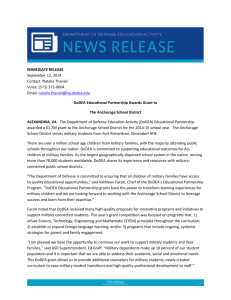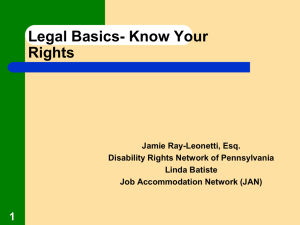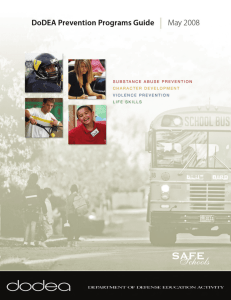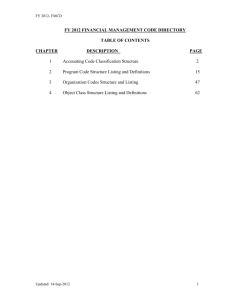DoDEA (504) Accommodation Plans
advertisement
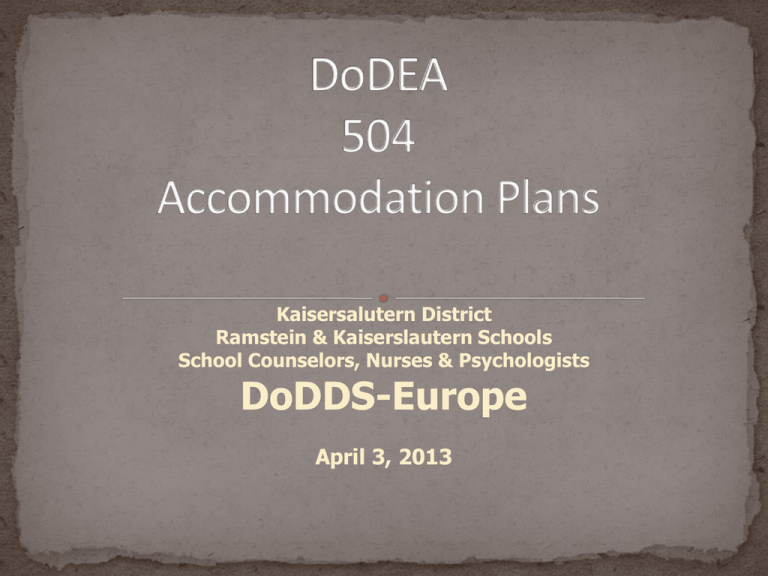
Kaisersalutern District Ramstein & Kaiserslautern Schools School Counselors, Nurses & Psychologists DoDDS-Europe April 3, 2013 “A student with a disability, or who has a record of a disability, or is regarded as having a disability, shall not be excluded from participating in, or be denied the benefits of, any DoDEA education program or activity; or be subjected to discrimination based solely on a disability.” “DoDEA schools will provide a free appropriate public education (FAPE): -to students with disabilities -by implementing reasonable 504 Accommodations -upon establishing a student has a disability requiring such 504 Accommodation.” p.2, 4.b Establish Accommodation Teams & Team Leaders at beginning of school year Make adequate resources available Review accommodation plans annually Inform teachers of students 504 plans Receive and resolve parent concerns Post notices of nondiscrimination p.5-6 Process referrals & evaluate records Determine eligibility Prescribe 504 accommodation plans Leader: Coordinate all aspects of accommodation team process Document decision in writing and provide copy to parent Ensure minutes of meetings are recorded Secure all notices & consents to parents, sponsors, guardians p.6-7 Implement accommodations Participate in accommodation teams Assist administration in resolution of complaints When: Any time By Whom: Parent, teacher, student, counselor, nurse school or medical personnel, community agency Identify What: Student’s substantially limited performance in one or more major life activities believed to be caused by physical/mental impairment; or Student records or documents that student has a record of, or regarded as, having a physical/mental impairment Enrolls with a 504 Accommodation Plan; Has a major health concern, especially if documented on an Individual Health Plan (IHP), that is suspected of substantially limiting major life activity; Requires physical accommodations to access the school; Continues to display academic and/or behavior problems after receiving SST services; or Has been referred to the CSC but the student is ineligible or will not be evaluated 504 IEP Enrolls with a 504 Plan Enrolls with an active IEP Major health concern Enrolls with an expired IEP Requires physical Enrolls with a partially accommodations for access Academic/Behavior problems after receiving SST services Determined ineligible for special education or decision not to evaluate completed evaluation for special education Shows poor academic performance and failed response to intervention The 504 Accommodation Team will evaluate the student’s needs and may consider: -Records -Observations -Teacher Reports -Informal/Formal Assessments *The Accommodation Team may request additional assessments and should develop an assessment plan, obtain parent consent, and provide at no cost to the parent* 1. Does the student have a physical or mental impairment? - “physiological disorder or condition, cosmetic disfigurement, anatomical loss affecting body system, mental or physical disorder” Mental or physical impairments are not limited to specific diseases or categories of medical conditions. 1. Does the impairment substantially limit a major life activity? - “barrier to student performing major life activity (seeing, hearing, eating, thinking, concentrating, etc.) compared to other students NB: If both, “YES,” student is eligible for accommodations Disability must be the reason why the student cannot equally access from the school’s program and services. Think: “Level Playing Field” Access vs. Educational Benefit Wheelchair example o ADHD example Simply having a disability or condition does not automatically qualify a student for a DoDEA Accommodation Plan. The condition or disability must be a barrier to the student performing one or more major life activities as compared to an average student in the general population. This may be evaluated by considering the manner, conditions, and duration in which a student performs a major life activity in comparison to how non-disabled students perform the same activity. Major life activities are basic activities that the average person in the general population can perform with little or no difficulty. Major life activities include, but are not limited, caring for oneself, walking, seeing, hearing, speaking, breathing, performing manual tasks, and learning. Each DoDEA school is responsible A school may elect to use an existing educational team, (other than the CSC) Parents/guardians will participate on these teams to the greatest extent possible. The local team reviews the nature of the student’s impairment to determine how it affects his or her access to educational programs and activities. If the team determines that the student’s impairment substantially limits a major life activity, he or she will be identified as a qualified student with a disability. The local team will then proceed to develop an individualized DoDEA Accommodation Plan outlining necessary accommodations to ensure the student has educational opportunities and benefits equal to those provided to nondisabled students. In DoD schools, the GENERAL EDUCATION STAFF is responsible for reviewing 504 eligibility for students and for developing and implementing DoDEA Accommodation Plans. SST & 504 not necessary prerequisite for CSC referral When in doubt in the presence of a suspected disability, use the CSC process Describes the 504 meeting as an eligibility meeting Specifically refers to eligibility questions “unduly burdensome” determined by DoDEA OGC Refers to new Disciplinary Reg and Manifestation Determination meetings, outcome is different for 504s and IEPs In 2012, 504 Form was revised Accommodations include adaptations and modifications that a student may need to participate in DoDEA programs and activities. Most reasonable accommodations will occur in the student’s general classroom and involve minor adjustments that enable the student to obtain equal access to learning opportunities. Reasonable accommodations may include, but are not limited to, a change is the student’s seating arrangement, visual aides, large print educational materials, use of video recordings, and extended time to complete specific tasks. Hearing 12 Vision 7 Asthma 4 Seizure Disorder 11 Severe Allergy 5 Diabetes 10 Heart Condition 0 Digestive Disorder 2 Cerebral Palsy 0 ADD/ADHD 201 Dyslexia 17 Communication 2 Anxiety 25 Depression 8 Oppositional Defiant Disorder 2 Other 81 4% 2% 1% 3% 2% 3% 0% 1% 0% 63% 5% 1% 8% 3% 1% 25% People may select more than one checkbox, so percentages may add up to more than 100%. People may select more than one checkbox, so percentages may add up Preferential seating Extended time for testing up to 150% Testing in small groups/distraction-free Check for understanding/attention Verbal and visual cues Daily agenda/planner/assignment sheet check Shortened assignments Task broken down into shorter steps/assignments Extended time for task completion Use of assistive technology change of response mode Accommodate for specific allergies 167 158 112 91 90 90 80 64 135 42 8 5 Yes, but only if the accommodation is documented in the student’s DoDEA Accommodation Plan or has been used routinely in the student’s educational program And is allowed by the test manual Does not directly apply to all students on 504 Accommodation Plans A special medical need is determined by threshold criteria for each condition It is the responsibility of the sponsor/parent to know the thresholds For 504 plans, the Coding form only requires checking the box and attaching the 504 plan Extended time often helps students regardless of their disability status. It can change the proper interpretation of students’ test scores. Decisions about it are not made consistently. Other interventions may help to decrease students’ reliance on it. Q: When working on a 504 plan for a student, do all core teachers have to be present at the meeting? Q: Can a 504 plan be developed for a student that is suspected of having an impairment or is possibly impaired, but has not been evaluated? Q: How recent must an evaluation be? Q: May personnel resources be allocated on a 504 plan? Q: Can a 504 Plan be used as a basis for graduation requirement waivers? 504 plans are designed to ensure ACCESS by leveling the playing field Students with good grades might still experience barriers to access, and could be eligible Like the SST, 504 Team is General Ed (not Special Ed),identified at beginning of the year, with leader(s) selected. Alert nurses to 504 protections for students on Individual Health Plans In regard to Discipline and Attendance Policies, students with disabilities may have 504 protection even without a 504 Plan.

